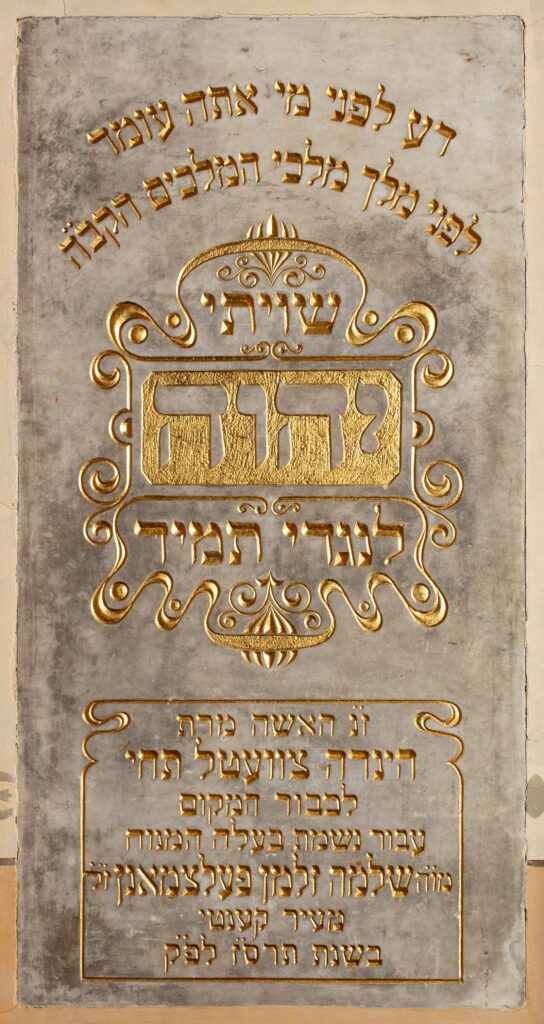The Shiviti tablet (Hebrew for “I place”) is located on the eastern wall in the main prayer room for men, on the right side of the Aron ha-Kodesh at the Chevra Lomdei Mishnayot Synagogue in Oświęcim. The plaque was presumably placed in the synagogue after World War II by Holocaust survivors, since its content refers to the nearby town of Kęty. It was founded in 1907 by Hinda Cwetl, in memory of her late husband, Shlomo Zalman Pelcman of Kęty, a teacher and rabbi. The name shiviti comes from the first word of Psalm 16:8 “I place myself always before the Lord,” and its content is as follows: Know before whom you stand. Before the King of Kings over Kings – the Holy One [God] – Blessed is He. I always have God before me. This is a gift from the woman Hinda Cweth [May She Live] in honor of the Omnipresent One and in memory of her late husband. Our teacher and Rabbi Shlomo Zalman Pelcman [Blessed be His memory] from the city of Kęty in the year 667 [=1907] according to the abbreviated reckoning of time (translated from Hebrew by Yale Reisner and Jacek Proszyk). The Chevra Lomdei Mishnayot (Hebrew: Association of Mishnah Students) was registered in 1893. It had a prayer and educational character. In the years 1893-1939 the Association was led by, among others: Natan Silbiger, Abraham Kaufmann, Salomon Joachim Barber and Jakób Singer. In the interwar period the post of rabbi was held by: Yekele Jankiel Zukerberg from Komarno, son-in-law of the admor from Sassow, later replaced by Chaim Yehuda Judel Halberstam. The number of members of the organization ranged from 90 to 120. Originally, the association did not have its own headquarters and its members met in the house of prayer of the Chrzanów Chasidim (the so-called Chrzanów shtibl) at Szpitalny Square (currently Jan Skarbek Square). In 1912, the Lomdei Mishnayot Association bought the property from a married couple, Józef and Gizela Glass, and in 1913 began efforts to build their own headquarters and house of prayer. The newly established synagogue functioned until 1939. During the war, its interior was completely destroyed and the building was used, among others, as a German ammunition warehouse. Moreover, in September 1940, 70 Jews displaced from Zator and Wadowice were placed there. After World War II, the synagogue was briefly restored to its original function (1945-1955). A handful of Oświęcim Jews who survived the Holocaust prayed there. After they left Oświęcim, the building housed warehouses and a carpet warehouse (1992-1997). In 1998, the synagogue was returned to the Jewish Religious Community in Bielsko-Biała, which donated it to the Auschwitz Jewish Museum. The site is the only surviving house of prayer in Oświęcim and, at the same time, an example of a typical Beit Midrash (Hebrew for “house of learning”) from the early 20th century, which combined the functions of a house of prayer and a place of religious education. In the men’s section there are two historical tablets. The first one, placed on the mechitza, the wall separating women from men, commemorates the three gabayim – synagogue administrators: Jakir Singer, Chaim Goldstein and Alter Neuberg (1928). It is the only original element from its pre-war decor. The second one is the presented shiviti.
| Inventory number: | MZ-47-O |
| Name: | Shiviti plaque |
| Source: | Auschwitz Jewish Center in Oświęcim |
| Dating: | 1907 |
| Dimensions: | no information |
| Material: | no information |
| Execution technique: | no information |
Digitalisation: Regional Digitalisation Lab, MIK, Oshpitzin means Oświęcim project.

